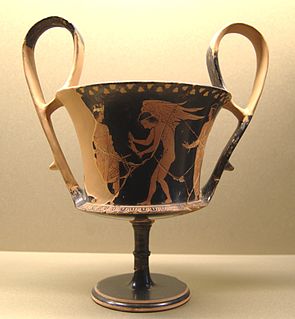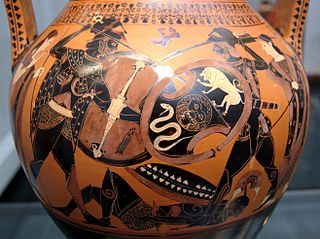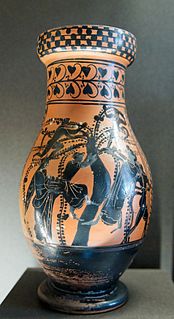The Painter of the Dresden Lekanis is the common name for a vase painter of the Attic black-figure style, active around 580-570 BC. He emigrated to Boeotia and is in fact identical with the Boeotian Horse-bird Painter.
His conventional name is derived from his name vase, a lekanis at Dresden (Inv. ZV 1464). A typical feature of his works are animal friezes, especially with sirens; their execution has been characterised by John Boardman as a caricature of the figures by the KX Painter. His works have been found not only in Attica, but also in Taranto, Smyrna and Ampurias (Spain).
The majority if his vases are made of a lighter-coloured clay than usual for Attic vases; which is explained by his emigration to Boeotia, where such clay was in use. In Boeotia, his painting style became coarser, but his specific style with characteristic incisions and the use of additional colours leaves no doubt as to the identity of the painter. His production in Boeotia was much more extensive than previously in Athens. More than 60 vases by him are known, the majority are alabastra . He maintained his predilection for sirens. His works were apparently all discovered in Greece, predominantly in Boeotia.

Black-figure pottery painting, also known as the black-figure style or black-figure ceramic is one of the styles of painting on antique Greek vases. It was especially common between the 7th and 5th centuries BC, although there are specimens dating as late as the 2nd century BC. Stylistically it can be distinguished from the preceding orientalizing period and the subsequent red-figure pottery style.

Red-figure vase painting is one of the most important styles of figural Greek vase painting.

The Shuvalov Painter was an Attic vase painter of the red-figure style, active between 440 and 410 BC, i.e. in the High Classical period.

The Painter of Berlin A 34 was a vase painter during the pioneering period of Attic black-figure vase painting. His real name is unknown, his conventional name derived from his name vase in the Antikensamlung Berlin. He is the first individual vase painter of the style in Athens recognised by scholarship. His works are dated to circa 630 BC. Two of his vases were discovered in Aegina. Since the 19th century, those pieces were on display in Berlin, but they disappeared or were destroyed during the Second World War.

The Cerameicus Painter was one of the first Attic black-figure vase painters. He was active around 600 BC.
The Comast Group was a group of Attic vase painters in the black-figure style. The works of its members are dated to between 585 and 570/560 BC. The artists of the Komast Group are seen as the successors of the Gorgon Painter. Its most important representatives were the KX Painter and the slightly later KY Painter. They painted vases shapes that had been newly introduced to Athens or that had not previously been painted. Especially commonly painted by them were '’kothon’’ and lekanis. From Corinth, then still the centre of Greek vase painting, they adopted the Komast cup and the skyphos (known as kotyle. The KY Painter introduced the column krater. Also popular at the time was the kantharos. The group adopted the Corinthian habit of depicting komasts, after which the group is named. It provided the group’s most commonly painted motif. The komast scenes permit Attic artists for the first time to reach the artistic levels of middle-ranking Corinthian vases. While the older KX Painter still mostly painted animals and only the occasional komast scene, the komos became a standard motif for the KY painter and further inferior successors. It is not clear to what extent the painters of the group really cooperated. It is possible that they all worked in the same workshop. The group influenced later Attic vase painters, including the Heidelberg Painter. Works by the Komast Group were not only found in Attica, but appear to have been exported widely. Vases and fragments have been found at many sites, including Naukratis, Rhodes, Central Italy, Taras, and even Corinth.

The KX Painter was an Attic black-figure vase painter. He was active between 585 and 570 BC.
The Panther Painter was a vase painter of the Attic black-figure style. He was probably active at the same time as the Nessos Painter, or shortly thereafter. Both shared a predilection for interlace patterns. The Panther Painter's vases have so far only been found in Attica, but outside Athens, at Vari. It is therefore assumed that he did not live and work in Athens, but only produced for a small local market in Attica. He mainly painted lekanis with animal friezes.

The Polos Painter was a vase painter of the Attic black-figure style. His works date to c. 575 to 565 BC.

The C Painter was one of the most important Attic black-figure vase painters. His works date to circa 575–550 BC. His conventional name was allocated by the archaeologist John Beazley. The C stands for "Corinthianising", a reference to the strong influence of Corinthian vase painting on the artist. He was successor to the Comast Group and used the relatively old-fashioned range of vessel shapes preferred by that group, including lekanis, tripod kothon and skyphos. In contrast, he also painted quite innovative lekythoi with pronounced shoulders, although the more conservative Deinaeira type was still in use by some workshops at his time. The C Painter was the first Attic vase painter to paint cups without an offset lip, the Merrythought cup.

The BMN Painter was an Attic vase painter in the black-figure style, active during the third quarter of the 6th century BC.

The Painter of Munich 1410 was an Attic black-figure vase painter, active in the third quarter of the sixth century BC. His real name is not known. He was one of the late representatives of the black-figure style, which was in its final phase due to the introduction of red-figure vase painting. His conventional name is derived from his name vase, on display in the Staatliche Antikensammlungen at Munich. Although he is not considered an outstanding artist, some notable works are ascribed to him.

The Rycroft Painter was an Attic late black-figure vase painter, active in the final decade of the sixth century BC. His real name is not known.

The term Class of Cabinet des Médailles 218, or Class of Cab. Méd. 218 or Class of C.M. 218 describes both a group of Attic black-figure vase painters, and a type of vase they produced. They belong to the final third of the sixth century BC.

The Euphiletos Painter was an Attic black-figure vase painter active in the second half of the sixth century BC.

The Madrid Painter was an Attic black-figure vase painter active during the late period of the style, around 520 BC.

The Lysippides Painter was an Attic vase painter in the black-figure style. He was active around 530 to 510 BC. His real name is not known.

The Edinburgh Painter was an Attic black-figure vase painter, active around 500 BC. His speciality was white-ground lekythoi painted in the black-figure style.

The Gela Painter was an Attic black-figure vase painter. His real name is unknown. His long career started around the turn of the 6th and 5th centuries BC. A majority of his works, consisting mainly of lekythoi were exported to West Greece. His work was strongly influenced by the newly developed red-figure style. His style is often careless, but his images are original. Especially his mythological and genre scenes are notable. Often, his compositions on smaller vases mirror those normally used on larger, more expensive, ones. On his shoulder ornaments, he replaced the conventional buds with leaves.

Boeotian vase painting was a regional style of ancient Greek vase painting. Since the Geometric period, and up to the 4th century BC, the region of Boeotia produced vases with ornamental and figural painted decoration, usually of lesser quality than the vase paintings from other areas.

















